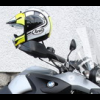Usralo i Smajsera! Jos da uvedu neka automatske ziroskope pa sam da ga naginje u krivinama i eto zabave
Evo C/P teksta, ne mogu da ga prepricavam
Function and Technology of BMW's New ASC
ASC (Automatic Stability Control) limits and controls spin on the rear drive wheel. It therefore prevents the rear wheel from spinning out of control under acceleration on slippery surfaces and helps to avoid a possible loss of lateral stability.
Acting as the logical counterpart to ABS, ASC is the first step towards enhanced rider assistance systems controlling riding dynamics on the motorcycle.
Currently BMW is the only motorcycle manufacturer in the world to offer traction support as an option on series production motorcycles: Upon the introduction of ASC in 2007, customers will be able to order this revolutionary new system for all Boxer models with the exception of the R1200S Sports Boxer and the K1200GT.
ASC is available only in combination with Integral ABS (while ABS without ASC is naturally still available as before). ASC assists the rider when accelerating on difficult and slippery surfaces, and offers extra safety particularly on rapidly changing road surfaces difficult to assess in terms of surface grip and friction.
It is not conceived, however, for maximum acceleration or for accelerating all-out while leaning over sharply, for example in a bend. Within the usual limits of physics, however, Automatic Stability Control is able to reduce any side swerve effect of the rear wheel also in a bend, thus helping to enhance the motorcycle's riding stability.
But it is important to note that ASC cannot enhance the natural, physical limits to the stability of a single-track vehicle, and that it does not relieve the rider from the need to use engine power appropriately when leaning over to a low angle.
An additional function of ASC is that it prevents the front wheel from lifting off when accelerating under full power – again an important contribution in the interest of extra safety. Function and control. ASC uses the ABS wheel sensors to monitor the speed at which the wheels are turning and also applies the diagnostic functions offered by these sensors.
Wheel spin, in turn, is determined by the engine's electronic "brain" comparing the speed of the front and rear wheels. Should the system detect any tendency of the rear wheel to spin, electronic engine management will intervene accordingly, setting drive forces to the limit the tire is still able to convey. The first step in this process is to reduce torque by adjusting the ignition angle (or, to be more specific, by retarding the ignition timing point).
Should a greater reduction of engine power be appropriate, fuel injection will be stopped for a certain period. An advantage of this control function is that it is quick and sensitive, with hardly any impairment of riding comfort and dynamic performance. The rider is informed of the function when active by a telltale flashing on and off quickly in the control panel.
And if the rider does not wish to use ASC, he is able to deactivate the system at any time, also while riding, simply by pressing a control button. Additional off-road set-up for the GS models. An additional off-road set-up has been developed and memorized within the control system for off-road use of the R1200GS and R1200GS Adventure.
This special off-road mode takes wheel slip and spin conditions on loose surfaces into account, allowing a higher level of spin under such circumstances. Pressing the ASC button, the rider is able to switch over from the road to the off-road mode and vice versa. It is important to note that the off-road setup is not suitable for road use.
Supreme functional safety and reliability through integration of control systems. ASC Automatic Stability Control has been developed together with BMW Motorrad's new Integral ABS and the ASC software programmed as part of the overall engine control electronics.
This saves the need for a separate ASC control unit, reducing weight and space requirements accordingly. Full integration of the system also saves the need for additional connections in the interest of enhanced safety and minimum risk of interference.
Like all electronic control functions, ASC also features self-diagnosis and a defect memory for reading out information when the motorcycle is serviced. And should, finally, ASC not be available, the rider is informed accordingly by the telltale on the control panel.


